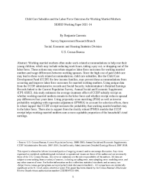
An official website of the United States government
Here’s how you know
Official websites use .gov
A .gov website belongs to an official government organization in the United States.
Secure .gov websites use HTTPS
A lock (
) or https:// means you’ve safely connected to the .gov website. Share sensitive information only on official, secure websites.
-
//
- Census.gov /
- Library /
- Census Working Papers /
- Child Care Subsidies and the Labor Force Outcomes for Working Married Mothers
Child Care Subsidies and the Labor Force Outcomes for Working Married Mothers
Child Care Subsidies and the Labor Force Outcomes for Working Married Mothers
Introduction
Working married mothers often make work-related accommodations to help rear their young children, which may include reducing work hours, taking a pay cut, or dropping out of the labor force. These actions may exacerbate negative labor force outcomes for working married mothers and wage differences between working spouses. Since the high cost of paid child care may lead to these work-related accommodations, child care subsidies, like the Child Care Development Fund (CCDF) for low-income families, may prevent these accommodations from occurring and improve labor force outcomes for married working mothers. Using unique data from the CCDF administrative records and Social Security Administration’s Detailed Earnings Records linked to the Current Population Survey, Annual Social and Economic Supplement (CPS ASEC), this study estimates the average treatment effect of CCDF subsidy receipt on whether working married mothers remain in the labor force and whether receipt reduces spousal pay differences four years later. Using propensity score matching (PSM) as well as inverse probability weighting with regression adjustment (IPWRA) to account for selection effects, there is robust support that CCDF receipt increases the probability that working married mothers stay in the labor force. There also is support from the doubly robust IPWRA models that CCDF receipt helps working married mothers earn a more equitable proportion of the household’s total earnings.
Others in Series
Working Paper
Working Paper
Working Paper
Share
Related Information
Some content on this site is available in several different electronic formats. Some of the files may require a plug-in or additional software to view.
 Yes
Yes
 No
NoComments or suggestions?


Top

